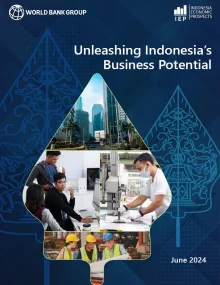Indonesia Economy Projected to Remain Resilient
JAKARTA – Indonesia’s economy is expected to grow at a steady pace in the coming years, driven by a pickup in public spending, rising business investment and steady consumer demand, the World Bank said today in a new report.
Indonesia’s gross domestic product growth is forecast to average 5.1% per year from 2024 to 2026, the World Bank’s Indonesia Economic Prospects report said, despite headwinds from a subsiding commodity boom, increased volatility in food and energy prices, and rising geopolitical uncertainty.
“Indonesia’s successful economic performance is in big part thanks to the government’s robust macroeconomic policy framework, which helped attract investment,” said World Bank Director for Indonesia and Timor-Leste Carolyn Turk. “It is important to maintain prudent, credible, and transparent macro policy, whilst creating fiscal space that enables priority spending on social protection and investment in human capital and infrastructure.”
Rising food prices lifted headline inflation this spring. Consumer prices rose 2.8% from a year earlier in May, up from a 2.6% year-over-year increase in January. Adverse climate conditions reduced domestic rice harvests and affected food prices more broadly. Headline inflation is expected to average around 3% in 2024.
In April 2024, Bank Indonesia raised its benchmark interest rate by a quarter percentage point to 6.25%, the highest level since 2016. The rate hike came as central banks in advanced economies delayed anticipated policy rate cuts, triggering notable portfolio and other investment outflows, and causing currency pressures in Indonesia and other emerging markets. Bank Indonesia is expected to begin cutting rates next year.
The government is ramping up social spending and public investment while revenues decline because of subsiding commodity windfalls. Public debt is projected to remain steady.
The report also highlights four emerging structural challenges: rising concentration in the manufacturing sector, slowdown in reducing regional income disparities, weaker wage growth and rising inequality since the COVID-19 pandemic, and limited geographic mobility of the labor force, which makes it harder to match workers with jobs and locations that lead to improved living standards.
The second part of the report focuses on Indonesia’s pathway to a more dynamic and productive economy—and achieving its goal of climbing from middle-income status to high-income status by 2045.
“A boost in private sector investment and dynamism is needed to accelerate long-term growth,” said World Bank Lead Economist for Indonesia and Timor-Leste Habib Rab. “This calls for regulatory reforms that help open markets and enhance the productivity of firms across manufacturing and services.”
The Indonesia Economic Prospects is supported by funding from the Australian Department of Foreign Affairs and Trade.

